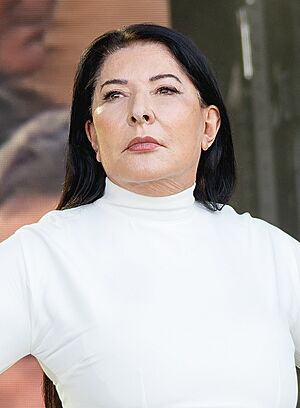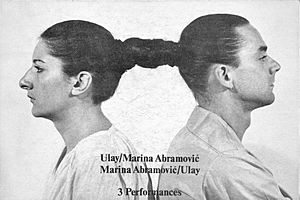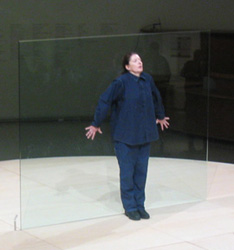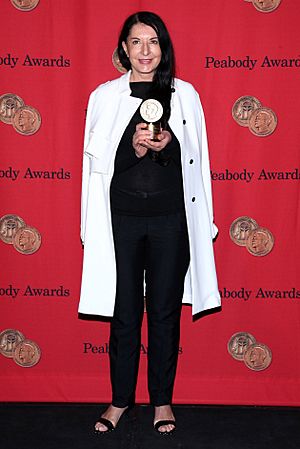Marina Abramović facts for kids
Quick facts for kids
Marina Abramović
|
|
|---|---|
| Марина Абрамовић | |

Abramović in 2024
|
|
| Born | November 30, 1946 Belgrade, PR Serbia, FPR Yugoslavia
|
| Education |
|
| Known for |
|
|
Notable work
|
|
| Movement | Conceptual art |
| Spouse(s) |
Neša Paripović
(m. 1971; div. 1976)Paolo Canevari
(m. 2005; div. 2009) |
| Partner(s) | Ulay (1976–1988) |
Marina Abramović (born November 30, 1946) is a Serbian artist famous for her work in conceptual art and performance art. In performance art, the artist's own body and actions are the artwork. Abramović's work often explores the limits of the human body and mind. She also studies the connection between the artist and the audience.
Active for over fifty years, Abramović is sometimes called the "grandmother of performance art." She introduced new ideas to art by involving the audience in her work. She often focuses on facing difficult challenges and testing her physical limits. In 2007, she started the Marina Abramović Institute (MAI) to support performance art.
Contents
Early life and education
Abramović was born in Belgrade, which was then part of a country called Yugoslavia. Her family was part of the wealthy, ruling class. Her great-uncle, Varnava, was a leader in the Serbian Orthodox Church. Both of her parents were soldiers called Yugoslav Partisans during World War II.
For the first six years of her life, Abramović lived with her deeply religious grandparents. After her younger brother was born, she moved in with her parents. She began taking lessons in piano, French, and English. She loved to paint as a child and showed an early interest in art.
Life at home was often difficult because of her mother's strict rules. In an interview, Abramović said her mother had "complete military-style control" over her and her brother. She was not allowed to be out of the house after 10 p.m. until she was 29 years old. She said that all of her early performances in Yugoslavia had to be finished before 10 p.m. so she could get home on time.
Abramović studied at the Academy of Fine Arts, Belgrade from 1965 to 1970. She later completed more studies in art in Zagreb, SR Croatia, in 1972. She then taught at an art academy in Novi Sad while starting her career as a performance artist.
Art career
The Rhythm Series (1973–1974)
Abramović became known for a series of performances called Rhythm. These artworks tested her physical and mental limits.
- Rhythm 10 (1973): In her first major performance, Abramović played a version of the knife game. She quickly stabbed a knife between the fingers of her hand. Each time she accidentally cut herself, she would pick up a new knife. She recorded the sounds and then tried to repeat the entire action, including the mistakes. This piece explored the body's limits and the connection between past and present.
- Rhythm 5 (1974): In this piece, Abramović lit a large wooden star soaked in petroleum on fire. She cut her hair and nails and threw them into the flames. Then, she jumped into the center of the star. She soon lost consciousness from the lack of oxygen. Audience members had to pull her out when the flames got too close.
- Rhythm 0 (1974): This is one of her most famous performances. Abramović stood still for six hours and let the audience do whatever they wanted to her using 72 objects she placed on a table. Some objects were gentle, like a feather and a rose. Others could be used to cause harm, like scissors and a whip. At first, the audience was calm. But as time went on, their actions became more aggressive. This piece explored how people behave when there are no rules.
Working with Ulay
In 1976, Abramović met a German performance artist named Uwe Laysiepen, who was known as Ulay. They started working together and became partners in life and art. They explored ideas about identity and relationships. They called their combined artistic self "The Other."
For over a decade, they created many "relation works":
- Relation in Space (1976): The two artists ran towards each other and collided repeatedly for an hour.
- Breathing In/Breathing Out (1977): They pressed their mouths together and breathed only each other's exhaled air. They did this until all the oxygen was used up, and they were left breathing carbon dioxide.
- Rest Energy (1980): Abramović held a bow while Ulay held the string with an arrow pointed at her heart. The piece showed complete trust and the tension in their relationship.
- Lovers (1988): To end their relationship, they walked the Great Wall of China. They started from opposite ends and met in the middle to say goodbye. Each of them walked over 2,500 kilometers.
Famous solo performances
After her work with Ulay, Abramović continued to create powerful solo pieces.
Balkan Baroque (1997)
This performance was a response to the Yugoslav Wars in the 1990s. For four days, Abramović sat on a large pile of cow bones and scrubbed them clean. The piece was a statement about the impossibility of cleaning away the shame and sorrow of war. For this work, she won the Golden Lion award, a top prize in the art world.
Seven Easy Pieces (2005)
At the Guggenheim Museum in New York, Abramović recreated seven famous performance art pieces from the 1960s and 1970s. She performed one piece each night for seven nights. The performances were very demanding, both physically and mentally. By redoing these historical works, she paid tribute to the artists who first created them.
The Artist Is Present (2010)
For her exhibition at the Museum of Modern Art (MoMA) in New York, Abramović performed a new piece. For 736 hours, she sat silently in a chair in the museum's atrium. Visitors were invited to sit in a chair opposite her and share a moment of silence while looking into her eyes.
The performance became incredibly popular. Thousands of people waited in line for a chance to sit with her, including celebrities like James Franco and Lady Gaga. Many people were moved to tears by the experience. The performance made Abramović famous to a much wider audience.
Later career and other projects
Abramović has continued to be a major figure in the art world. In 2007, she founded the Marina Abramović Institute (MAI), an organization dedicated to performance art.
She has also worked with other famous artists and celebrities. In 2013, she collaborated with the pop singer Lady Gaga on her album Artpop. She also inspired the rapper Jay-Z, who created a performance piece based on her work.
In 2021, she created a monument called the Crystal wall of crying at the site of a Holocaust memorial in Ukraine. In 2023, she became the first woman to have a major solo exhibition in the main galleries of the Royal Academy of Arts in London.
Personal life
Abramović has said she does not identify as Serbian or Montenegrin, but as someone from a country that no longer exists (Yugoslavia). She has been married twice but has no children. She has said that having children would have been a "disaster" for her work.
In 2020, Abramović became the target of online conspiracy theories that falsely accused her of being involved in satanic rituals. These claims were based on a misunderstanding of her art piece Spirit Cooking. She has denied these accusations, explaining that her work is art and should be understood in an art context.
Awards
Abramović has received many awards for her contributions to art, including:
- Golden Lion at the Venice Biennale (1997)
- Austrian Decoration for Science and Art (2008)
- Princess of Asturias Awards for the Arts (2021)
- Sonning Prize (2023)
- Praemium Imperiale (2025)
See also
 In Spanish: Marina Abramović para niños
In Spanish: Marina Abramović para niños





